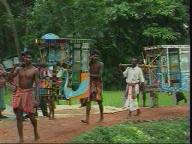
 |
|
|
Where Palanquin Is Still in Use to Display One's 'Class' (October, 2002) KOLKATA: West Bengal, which boasts of the country's first metro rail network, also uses palanquins for travelling from one place to another. This is at least true for a little known village of Gopmahal in Midnapore district.
The tradition of travelling by palanquins is 200 years old. But for the residents of Gopmahal and adjacent areas, it is a regular mode of transport, both long and short distances. At a time when automobiles weren't there, the palanquins provided an efficient mode of transportation for women and the rich class of people across rough terrain. In Gopmahal, however, the need for using palanquins was realised when the region was severely hit by floods in the past. A story goes that even flood waters don't stop palanquin bearers. But today it is more a show of socio-economic status, said Samiran Mullick, a palanquin bearer whose forefathers had been following the occupation traditionally. "Although there are other modes of transport available here, some affluent people still want to ride in palanquins to show they are different from those who can't easily afford them", Samiran said. The expenditure depends on the type of palanquin used and the route which one follows. As compared to an ordinary palanquin, a more expensive palanquin called Mayurpankhi costs somewhere between Rs 1,500 and Rs 2,500. In Gopmahal there are about 25 palanquins. A regular palanquin consists of a central space for seating one or two passengers with scaffolding on either side for bearers to carry it. Earlier, they were designed considering the need, social status and the journey. Amenities for reading, writing, eating and sleeping were provided. For short distances, two to six people were used but for longer distances an additional team of bearers accompanied to give relief to the tired. Depending on the mood of the traveller, readers, singers, dancers or story-tellers accompanied. In earlier days, palanquins were also used to carry the bride to her in-laws' place, a tradition that continues till today. But as time passed, they are gradually being replaced by modern modes of transport. "Their business has deteriorated these days but palanquins are needed here as a means of transport for those routes where normal mode of transport cannot reach," said Raghunath Chakravarty, a resident of Gopmahal who frequently travels by palanquins. Chakravorty says travelling by palanquins is not only more personalised and enjoyable but requires no fuel or good roads. There is also no scope for pollution and no fear of accidents. Metros can perhaps take a break . Darjeeling's
'Toy' Train Turns 122, SILIGURI: The world famous toy train of Darjeeling Hills completed 122 years of run recently. Officials decked it up to celebrate 150 years of Indian Railways. The train was conferred world heritage status in 1999, and the Darjeeling Himalayan Railway was the second railway line in the world to be declared a UNESCO heritage site. The first was Zemerin in Austria. "It was run 122 years ago, and this current financial year has been declared as an year for celebrating and remembering the birth of the Indian Railways, which took place 150 years ago," said V Nanda, General Manager of North-eastern Railways. However, Nanda added that maintaining the more than century-old train was not financially viable. "The DHR railway is a heritage railway but we are facing a financial problem in operating it," he pointed out. It is called "toy" because of its miniature size and snail-pace speed compared to regular locomotives. The DHR is famous for its non-engineering construction. It has three loops and six "Z" reverses on the entire line, which turns the concept of enginnering on its head. The track goes up and down the slopes till it reaches the tea abode of Darjeeling. There are no tunnels on the 88-km track from New Jalpaiguri to Darjeeling. The DHR route passes through Ghum, the second highest railway station in the world situated at a height of 7407 feet. The train still maintains its quaintness with wood compartments and no brakes. It travels at a romantic speed of 10 km per hour. Local travellers said the train evokes fond memories of the past. "It reminds me of my childhood days. I am born and brought up in pahar (hills). It is wonderful to go in this train and seeing this being decorated, decked up so well in comparison to what we used to have around 40s and 50s, it is a wonderful experience," said Phanindra Chandra, a local passenger. For the tourists, the charm of meandering through the meadows and hills, overlooking Kanchenjunga peaks on the Himalayas, is unique. "I last came in 1940. And now after all these years after this railway has been declared a heritage railway, I have come again. I feel great," said Morohori Bannerjee, a tourist. While less than one cent is charged for a seat in the second class compartment of the train, the other remaining compartment has been designated as first class and 1.5 dollars is collected from each passenger. The engineering marvel used by DHR was inspirational for several mountain railways in the world. And for this very reason, the UNESCO declared it as a world heritage site in 1999, to be saved from extinction. DHR was the result of the sole effort of Frankin Prestage, agent of the then Eastern Bengal Railways, who not only envisioned it but also played a major part in its construction. -ANI |
Previous Files Current Topics In Focus
|
